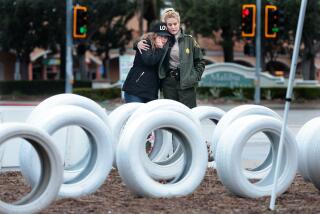State’s future may be paved with fees
- Share via
SACRAMENTO — In California, birthplace of the freeway, where motorists can traverse all but a small fraction of the state without encountering a tollbooth, the free ride may be coming to an end.
There is emerging consensus in the Capitol that the state should follow the path already blazed elsewhere and look to tolls to help bankroll new roads, public and private.
Local and state transportation agencies are already planning several such projects on busy urban corridors, and some of the world’s largest investment firms are lining up with proposals that could leave them in control of some major new roads.
Voters last November approved billions in borrowing for roads, but that was only a start; the money won’t meet all the state’s transportation needs and never was intended to. Nor would anything short of a major increase in the gas tax -- one for which voters appear to have no appetite. That leaves tolls.
“The existing way of paying for these projects is not going to work,” said Senate Transportation Committee Chairman Alan Lowenthal (D-Long Beach). “We’re used to free roads and everything being free. That is a 1950s model. If we want to move forward, we are going to have to head in a different direction.”
Under pressure from Gov. Arnold Schwarzenegger, who has been pushing for the state to start shifting the cost -- and some control -- of road building to the private sector, lawmakers last May authorized government agencies to build four demonstration projects in partnership with investment banks, shipping companies and other businesses.
The companies would put up money for the projects, and in return could end up owning a share of them. Or at least be guaranteed some of the revenues they generate.
*
Moving goods
The Legislature has yet to sign off on what roads would be built under the arrangement, but has stipulated that they must serve the movement of goods.
The California Department of Transportation is already suggesting a toll road for trucks that would go from the Port of Long Beach to the Inland Empire, and a toll road for cars and trucks at the Mexican border near San Diego that would have its own border crossing.
State and local transportation planners have joined with the governor’s office to lobby lawmakers for authority to broker more deals with private companies.
“This should only be a beginning,” Mark Pisano, executive director of the Southern California Assn. of Governments, said of the projects approved in May. At a recent legislative hearing, Pisano told lawmakers that his organization wants to work with private companies to build a controversial 8-mile tunnel that would link the 710 Freeway to Pasadena, a project estimated to cost at least $2 billion.
Federal transportation officials are cheering these planners on.
“This is the next step,” said Tyler Duvall, assistant secretary for transportation policy at the U.S. Department of Transportation. He flew to Sacramento from Washington last month to urge legislators to build more toll roads, preferably in partnership with the private sector.
“Every single private investor cites California as the dream place to invest,” he said.
Currently, the state has 82 miles of toll roads -- the first of which opened in 1993 in southern Orange County -- and drivers make about 590,000 trips on them daily. Tolls vary by route and time of day.
A short hop on the 73 tollway can cost as little as 50 cents. A one-way trip on the 10-mile-long 91 Express Lanes at rush hour can come to $9.25.
*
Many drivers opposed
The American Automobile Assn. in California, which has more than 6 million members, does not oppose tolls on new roads. But many drivers do.
“The lifestyle we have in this state is the result of our freeways,” said Pete Van Nuys, a San Clemente salesman who says he drives up to 60,000 miles a year. “If I have a small business, I should be able to drive and deliver goods and services without having to pay onerous tolls.”
Some taxpayer groups say the state should make better use of existing resources.
“We shouldn’t have to resort to toll roads,” said Jon Coupal, president of the Howard Jarvis Taxpayers Assn. “There are a host of studies showing we are simply not using our transportation dollars wisely. Before we dream up new ways to raise revenue, we should get smarter about how we use the money we have.”
Democrats have long resisted private toll roads, pointing to problems that have arisen in the state’s few experiments with private roadways. California, which once was a pioneer in public-private partnerships, soured on the idea after some high-profile missteps.
Example: In Orange County, to close a deal with a company called California Private Transportation, the state agreed not to make any improvements to public roads within a mile and a half of the company’s toll lanes on the 91 Freeway. Congestion in the public lanes grew intolerable, and the state ultimately bought the toll lanes for $207 million.
Meanwhile, a private toll road long ago authorized and finally scheduled to open in San Diego County this summer has been beset by lawsuits and cost overruns. The project’s final price tag -- $683 million -- is 70% higher than planners estimated.
The project initially called for the state to take control of the road after 35 years. Lawmakers last year scaled that back to 45 years so that the private company building it will be able to recoup its money by collecting tolls for an extra decade.
Officials in the governor’s office say such setbacks are minor bumps in the road.
“We have learned a lot of lessons” from California’s existing toll roads, said Sean Walsh, a senior policy advisor to the governor, “as have the rest of the country and the world.”
But, he added, “people who keep going back and looking at them as an example of something that is wrong ignore the fact that it is a model now being used successfully around the world.”
Indeed, several states are looking to private companies to take over their roads or build new ones. Indiana has turned over its 157-mile-long turnpike, known in the Midwest as the “Main Street of America,” to a consortium of foreign investors. Illinois negotiated a similar deal with its Chicago Skyway. New Jersey and Pennsylvania are exploring similar deals with their famed turnpikes.
*
Feeding a port
Texas, where virtually every major road currently being built will have tolls, is looking to the private sector to construct a 4,000-mile network of car and truck toll lanes that would feed into a port. The project, economists say, would position Texas to compete with California as the entry point for goods shipped from Asia, especially if the 710 Freeway continues to deteriorate.
In all, 21 states have passed laws encouraging public-private road-building partnerships. Many are making the move at the urging of the federal government, which provides financial incentives for involving the private sector.
California’s Legislature has stopped short of giving local transportation agencies broad authority to cut deals with private road builders, as other states have. Some planning experts and economists are encouraging them to step things up.
“California is famous for the freeway, and it has been a great thing,” said Joel Kotkin, an author of books on demographics and planning. “But it is from a time when the state had a lot of money coming in. We are in a different situation now. You have to start looking at these other options. The alternatives are gridlock or spending the state into bankruptcy.”
Others caution that international investment firms are accountable to their shareholders, not the driving public. They say California should seek alternatives that don’t give such companies too much control.
Regardless, drivers are eventually likely to be reaching for their wallets more often.
“New construction is going to have to be financed at least in part by tolls,” said Lowenthal. “Who will control them is an open question.”
*
*
(BEGIN TEXT OF INFOBOX)
Taking a toll
Twenty-six states currently have toll roads, ranging in miles from nearly 600 to one.
*--* Miles of State toll road Oklahoma 596.7 New York 574.6 Pennsylvania 533.0 Ohio 392.2 Florida 385.1 New Jersey 359.9 Illinois 282.1 Kansas 237.4 Texas 163.6 Indiana 156.8 Massachusetts 138.2 Maine 106.2 New Hampshire 97.1 Kentucky 93.6 West Virginia 86.8 California 82.0* Virginia 57.9 Colorado 57.5 Delaware 56.7 South Carolina 23.5 Vermont 11.9 Nevada 6.4 Georgia 6.2 Alabama 6.0 Louisiana 1.5 Utah 1.0
*--*
*Does not include the 17 Mile Drive on the Monterey Peninsula.
--
Existing California toll roads
Foothills Toll Road (28 miles): Southern section of 241, from east of Irvine to Oso Parkway south of Coto de Caza.
*
Eastern Toll Road (24 miles): Links 91 Freeway to several inland Orange County communities. Includes all of 261, northern section of 241 and northern section of 133.
*
San Joaquin Hills Toll Road (12 miles): Section of 73 Freeway linking Newport Beach to San Juan Capistrano.
*
91 Freeway Express Lanes (10 miles): Toll lanes on section linking Costa Mesa Freeway to Orange/Riverside County line.
*
I-15 Express Lanes (8 miles): Solo motorists can pay a fee to drive in the carpool lanes on an eight mile stretch of I-15 in San Diego County.
--
Data as of 2005
Source: Federal Highway Administration. Graphics reporting by Scott Wilson
More to Read
Sign up for Essential California
The most important California stories and recommendations in your inbox every morning.
You may occasionally receive promotional content from the Los Angeles Times.











